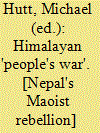| Srl | Item |
| 1 |
ID:
172984


|
|
|
|
|
| Summary/Abstract |
The huge disparity between the well-resourced, cosmopolitan capital, Kathmandu, and the still very basic living standards in other parts of the country remains glaring.
|
|
|
|
|
|
|
|
|
|
|
|
|
|
|
|
| 2 |
ID:
127074


|
|
|
|
|
| Publication |
2013.
|
| Summary/Abstract |
In Nepal, it is widely believed that in 1941 Yogmaya, a female religious ascetic, and 60 of her disciples drowned themselves in the Arun River. In many of her 'utterances' (bani), preserved in a book that was effectively banned in Nepal for 40 years, Yogmaya called upon the Rana government to establish a dharmarajya, a religious state. The mass suicide is now interpreted as an act of protest at the Ranas' failure to meet this demand. However, the event is not mentioned in any published history of Nepal. Yogmaya's revolt was 'rediscovered' by an American anthropologist in the 1980s and revealed to a group of activists in Kathmandu, who attempted to reinstate her in their country's political history. Twenty years later, Nepal's leading feminist journal launched a campaign to gain recognition for Yogmaya as Nepal's first woman rebel. A small-scale iconisation process has been underway ever since, with Yogmaya being constructed as, variously, a feminist leader, a progressive poet, an opponent of caste discrimination, and a political rebel. This article recounts the standard story of her life, evaluates recent constructions of her rebellion and attempts to explain the appeal of Yogmaya to progressive forces in modern Nepali society.
|
|
|
|
|
|
|
|
|
|
|
|
|
|
|
|
| 3 |
ID:
054675


|
|
|
|
|
| Publication |
London, Hurst and Company, 2004.
|
| Description |
xi, 322p.pbk
|
| Standard Number |
185065722X
|
|
|
|
|
|
|
|
|
|
|
|
Copies: C:1/I:0,R:0,Q:0
Circulation
| Accession# | Call# | Current Location | Status | Policy | Location |
| 048858 | 954.96/HUT 048858 | Main | On Shelf | General | |
|
|
|
|
| 4 |
ID:
061110


|
|
|
|
|
| Publication |
Jan-Feb 2005.
|
|
|
|
|
|
|
|
|
|
|
|
|
|
|
|
| 5 |
ID:
076480


|
|
|
| 6 |
ID:
111865


|
|
|
|
|
| Publication |
2012.
|
| Summary/Abstract |
Nepal's adoption of a new national anthem in 2007 reflected a decision to establish a new social and political order that was republican, federal and inclusive of the country's many minority communities. It came after a ten-year internal conflict, and was followed by the abolition of the Shah monarchy that had ruled the country since the late eighteenth century. This article describes the historical and political context of the decision to replace the old anthem, the selection of the new anthem, and the debates that arose in the Nepali media and public sphere after its lyrics and the identity of its author were made known. The discussion refers to arguments made by Karen Cerulo about the relationship between the syntactic structure of national anthems and the stage reached in the process of political modernisation of the nation-state in question, and provides some comparative perspectives on the Nepali case.
|
|
|
|
|
|
|
|
|
|
|
|
|
|
|
|